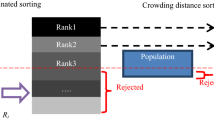Abstract
Recognizing non-recurrent events in short-term traffic flow evolution is of ultimate importance in advanced transportation systems. The present paper proposes a methodological framework for the recognition and prediction of complex and irregular traffic flow patterns; an advanced nonlinear analysis is conducted in order to recognize patterns with respect to the statistical characteristics of their evolution. Following, patterns are predicted using a genetically-optimized probabilistic neural network. Results indicate the existence of three basic types of temporal patterns: (a) stable, (b) unstable, (c) non-recurrent (unique). Moreover, the developed probabilistic network provides accurate one-step ahead pattern predictions. The proposed model infers knowledge on the occurrence of patterns and transitions and can be a significant source of information in order to improve on short-term predictability of traffic flow.
Similar content being viewed by others
References
Adeli, H., and Karim, A. (2000). A fuzzy-wavelet RBFNN model for freeway incident detection. J. Transp. Eng., 126(6), 464–471.
Dia, H., and Rose, G. (1997) Development and evaluation of neural network freeway incident detection models using field data.” Transp. Res., Part C, 5, 5, 313–331.
Florio, L., and Mussone, L., (1996). Neural-network models for classification and forecasting of freeway traffic flow stability, Control Engineering Practice, 4, 2, 153–164.
Fraser, A. M., and Swinney, H. L., (1986). Independent coordinates for strange attractors from mutual information, Physical Review A, 33 (2), 1134–1140.
Gao, J. and Cai, H, (2000). On the structures and quantification of recurrence plots, Physics Letters A, 270, 75–87.
Goldberg, D. E. (1989). Genetic Algorithms in Search, Optimization, and Machine Learning. Addison-Wesley, ISBN: 0201157675.
Ishak, S. S., and Al-Deek, H. M. (1998). ‘Fuzzy ART neural network model for automated detection of freeway incidents., Transp. Res. Rec., 1634, Transportation Research Board, Washington, D.C., 56–63.
Jiang, X., and Adeli, H. (2005). Dynamic Wavelet Neural Network Model for Traffic Flow Forecasting, Journal of Transportation Engineering, 13(10), 771–779.
Juan, Z., Wang, X. and Piao, J., (2004). Study on Traffic Flow Breakdown with Nonlinear Statistical Theory of Change-Point, In: Proceedings of the Eighth International Conference, May 26–28, Beijing, China, 578–583.
Kantz, H., and Schreiber, T. (1997). Non-linear time series analysis. Cambridge Non-linear Science: Series 7, Cambridge University Press.
Kennel, M. B., Brown R., Abarbanel, H. D. I., (1992). Determining embedding dimension for phase-space reconstruction using a geometrical construction, Physics Reviews A, 45, 3403.
Kerner, B. S. (2004). Three-phase traffic theory and highway capacity, Physica A, 333, 379–440.
Lin, C.-K., and Chang, G.-L. (1998). Development of a fuzzy-expert system for incident detection and classification, Math. Comput. Modell., 27, 9, 11, 9–25.
Marwan, N. Kurths J. (2002). Nonlinear analysis of bivariate data with cross recurrence plots, Physics Letters A, 302(5–6), 299–307.
Principe, J. C., Euliano N. R., Lefebvre C. W., (1999). Neural And Adaptive Systems: Fundamentals Through Simulations. John Wiley and Sons, Inc.
Roy, P. and Abdulhai, B., (2003). GAID: Genetic Adaptive Incident Detection for Freeways, Transportation Research Record, 1856, 96
Schreiber, T., (1999). Interdisciplinary application of nonlinear time series methods, Physics Reports 308, 1.
Shang, P., Li, X. and Kamae, S., (2005). Chaotic analysis of traffic time series, Chaos, Solitons & Fractals, 25, 1, 121–128.
Smith, B. L., Williams, B. M., and Oswald, K. R. (2002). Comparison of parametric and non-parametric models for traffic flow forecasting, Transportation Research Part C: Emerging Technologies, 10(4), 303–321.
Specht, D., (1990). Probabilistic neural networks, Neural Networks, 3, 109–118.
Stathopoulos, A., and Karlaftis, M. G. (2003). A multivariate state-space approach for urban traffic flow modeling and prediction, Transportation Research Part C, 11 (2), 121–135.
Teng, H. and Qi, Y., (2003). Application of wavelet technique to freeway incident detection, Transportation Research Part C 11, 289–308.
Turochy, R., E., (2006). Enhancing Short-Term Traffic Forecasting with Traffic Condition Information, Journal of Transportation Engineering, 132, 6, 469–474.
Vlahogianni, E. I., Golias, J. C, Karlaftis, M. G. (2004). Short-term Traffic Forecasting: Overview of Objectives and Methods, Transport Reviews, 24(5), 533–557.
Vlahogianni, E. I., Kalaftis, M. G., and Golias, J. C. (2005). Optimized and Meta-Optimized Neural Networks for Short-Term Traffic Flow Modeling: A Genetic Approach, Transportation Research Part C: Emerging Technologies, 13, 3, 211–234.
Vlahogianni, E. I., Karlaftis, M., G. and Golias, J. C. (2006). Statistical Methods for Detecting Nonlinearity and Non-Stationarity in Univariate Short-term Time-series of Traffic Volume, Transportation Research Part C, in press.
Webber Jr. C. L., and Zbilut J. P., (1994). Dynamical assessment of physiological systems and states using recurrence plot strategies, Applied Physiology, 76, 76 965.
Webber, C. L., Jr., Zbilut, J. P. (2005). Recurrence quantification analysis of nonlinear dynamical systems. Chapter 2, In: Tutorials in contemporary nonlinear methods for the behavioral sciences, The National Science Foundation, 4201 Wilson Boulevard, Arlington, Virginia 22230, USA.
Zbilut, J., P., Hu, Z., Giuliani, A., Webber, Ch., L., (2000). Singularities of the Heart Beat as Demonstrated by Recurrence Quantification Analysis, Proceedings of the 22″d Annual EMBS International Conference, July 23–28, Chicago IL.
Zbilut, P., Giuliani, A. Webber, C. L. Jr. (1998). Detecting deterministic signals in exceptionally noisy environments using cross-recurrence quantification, Physics Letters A, 246 (1–2), 122–128.
Author information
Authors and Affiliations
Rights and permissions
About this article
Cite this article
Vlahogianni, E.I. Prediction of non-recurrent short-term traffic patterns using genetically optimized probabilistic neural networks. Oper Res Int J 7, 171–184 (2007). https://doi.org/10.1007/BF02942386
Issue Date:
DOI: https://doi.org/10.1007/BF02942386




